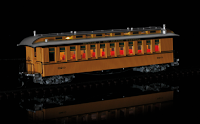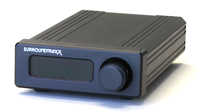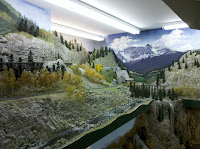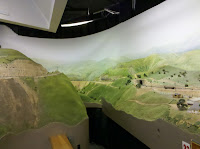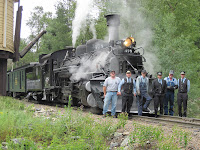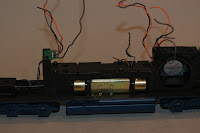We have many things to discuss, so we are posting another edition. This time, we will talk about an annual event at the Durango and Silverton, known as Railfest, The second installment from Jeff Johnson about gathering research and collecting prototype data for Blackstone Models, and a primer about the features and uses for our new SurroundTraxx. Also, don’t forget about the National Narrow Gauge Convention coming up soon, September 7th through the 10th in Hickory, NC
RailFest 2011
The Durango and Silverton Narrow Gauge Railroad Held its annual Railfest this past weekend. This annual event invites narrow gauge fans from all over to partake in special events, photo trains and excursion runs featuring visiting narrow gauge equipment. This year, the Eureka and Palisades #4
and the Rio Grande Southern Galloping Goose #5 were running, along with Denver and Rio Grande Western Painted passenger coaches and the #478, a K-28 Mikado.
On Saturday, Jarrette was front Brakeman on the #478 Photo Special while George rode and enjoyed the many run bys by taking video and still photos.
It left Durango at 6:30am and returned as the last entrant to the Parade of Trains at the Durango Depot.
Jeff played music on the Presidential Dinner Special on Sunday. Overall, it is a fun weekend and if given the chance, plan a trip out here in August to attend. We offer Factory Tours at SoundTraxx as well to complement the events in town for the week. For more information on Railfest, please visit
http://www.durangotrain.com/
Blackstone Models:
In our first installment of the Blackstone Models development process, Jeff Johnson, The Project Manager for Blackstone Models, discussed the decisions that go into determining the viability of a project and product selection. In this week’s entry, Jeff will focus on the research and development that goes into each new product to ensure the quality and accuracy for the new designs.
MEASURING UP
Through the years, there has been a maze of information and drawings compiled for many of the prototypes that we choose to re-create in HOn3. Most of the more popular drawings are quite fine in detail and dimensional integrity, while a few have appeared that are less than stellar in these respects and have occasionally resulted in questionable results when used for product development in the past. It became apparent early in our design process that we needed to get back to the original sources so we could use reasonably sound judgment as to the integrity of our model designs.
Does this mean that every fine rivet detail, nut, bolt, washer, etc. is always a flawless match for every single road number and era of a prototype? A qualified no on this one! Obviously a manufacturer has to determine a sensible way to bring a realistic model to fruition and also keep the development cost bearable for all. The qualifier for this one is that we find it very important to research the prototype early in our design phase so we may make decisions based on knowledge and not on ignorance due to hasty or incomplete data collection. Unavoidably, molding tolerances and model assembly processes will drive small compromises that are simply part of the manufacturing world, and we endeavor to know what we are starting from so that any such compromise is built on practical principals.
The following bullet points reflect the core of our resource material for model development and include the aspects we consider when observing information:
· Existing Prototypes
We spend time in the field after locating the best surviving prototypes and measure them in great detail. At this stage, some very important considerations must be taken into account;
1. Does the prototype generally match its appearance from the intended model era?
2. Have subsequent/modern era rebuilds altered dimensions or detail placement?
3. Does the prototype chosen best represent the entire class respective to subtle differences in individual pieces of rolling stock?
· Railroad Standard Drawings and Specifications
In conjunction with studying the field dimensions, we pour through all original source
material we can obtain in order to confirm or challenge findings in the field. Occasionally,
certain aspects of official standard drawings have even been found to be incorrect when
compared to the “as built” prototype. We also pay close attention to specification revision
dates in order to confirm that this data is concurrent with the era we are re-creating.
· Study of Historical Photographs
This exercise cannot be underestimated as many subtle variances among cars and
locomotives may be observed depending on the photo vantage points and the era represented.
We may also note road number specific paint and lettering details that can be applied to the
models in the decoration phase.
· Consultation with Historians
Blackstone Models has been greatly enriched through our association with respected
researchers. We don’t assume that the results of our own discovery phase are always ground
breaking. In fact many individuals have spent years collecting and analyzing unpublished
photos and documentation that may support or challenge previous conclusions. We are
extremely grateful for the remarkable outpouring of data that we have gleaned through the
assistance of others.
· Existing Products Comparison
After detailed study through the steps listed above, one may ask why it is necessary to
compare this information with other products. This is not to attempt the critique of other
manufacturers’ work, but rather to earn a respect for model standards that have gone before us
and to understand the perceptions and expectations that may exist for our customers.
We have developed a great deal of respect for many manufacturers that have paved the way
through the years with wonderful kits and thoughtful research. In fact, a few of us here at
Blackstone Models were building these kits and collecting early brass locomotives in our
formative HOn3 years. For this inspiration, we are quite grateful!
BRINGING IT TOGETHER
After collecting the needed data, a fairly arduous task commences with the creation of 3D prototype solid model drawings, road number versions matrices, and model livery specifications. And it never fails….as we confirm the final requirements of our prototype design, a few additional details have emerged that we can’t resist incorporating into the final product.
In our next installment, we will pass on some “fun facts” in the prototype-to-model phase, culminating with final production and the delivery of our latest HOn3 offering to our doors in Durango.
SurroundTraxx Overview
SurroundTraxx is a surround sound system for your layout. Utilizing the Digitrax Transponding block-detection system, the locomotive is detected in a particular block and this information is relayed back to the command station. SurroundTraxx listens for transponding communication and accordingly sends the sound profile of the detected locomotive to the speaker assigned to that region of the layout. As the locomotive traverses the layout, The Transponding detects the loco is in another block, and the SurroundTraxx transfers the sound to the speaker assigned to the new block. This allows the sound of the locomotive to follow from speaker to speaker, simulating on-board sound.
The SurroundTraxx is capable for support of up to 6 sound zones
or up to 5 zones while utilizing a subwoofer.
The SurroundTraxx will simultaneously produce sound for up to 6 locos at a time, but will store up to 99 locomotive profiles. The sounds for each loco will follow that loco from speaker to speaker around the layout. Even if all 6 locos are in one zone, all the sounds will emanate from one speaker. Setting up the locomotive profiles in the SurroundTraxx allows the user to fully customize the sounds for each loco, with multiple exhausts, whistles or horns, bells, air pumps or air compressors, coupler-clanks and more to faithfully match the intended prototypes.

Included in the box is the SurroundTraxx unit, a 6’ speaker harness, power supply, LocoNet cable and the User’s Guide on CD. We do not include speakers to allow the user to select the type of speakers they desire. For example, if Joe wants simple speakers on the layout fascia, he can use any bookshelf speaker, but if John wants to use the subwoofer, he would prefer less expensive, potentially smaller speakers, since the bass is coming from the subwoofer. Each layout is different as is the listener; so different speakers can be used with the SurroundTraxx to accommodate all preferences.
One example of the features built in the SurroundTraxx is the ability to add echo to a specific sound zone, giving the effect of running through a canyon. As the loco leaves this zone, the echo no longer applies to the sounds for that locomotive.
This is a new product that is shipping to dealers now. We are currently working on updating the SoundTraxx website to provide more information about SurroundTraxx and the concept behind the technology. Finally, big sound can come for the N- and Z- scalers with a full range of sound without having to fit tiny speakers onboard their locomotives. If you have any questions about the implementation of SurroundTraxx, feel free to call us and we will be glad to assist in any way we can!



